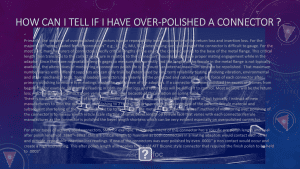Primarily, the indicator of over-polished connectors is poor repeatability in measurements of the return loss and insertion loss. For the majority of “spring-loaded ferrule connectors” e.g.; LC, SC, MU, FC.
Determining over-polishing of the connector is difficult to gauge. For the most part, manufacturers of connectors specify critical lengths of the end of the ceramic ferrule to the base of the metal flange. This critical length then translates to the correct exposure in relation to the connectors’ housing and assure proper mating engagement while in the adapter. Since there are no available length gauges to measure this correctly and the length of the ferrule in the metal flange is not typically available, the alternatives of monitoring a connector’s polish life are to “count” an internal maximum times to be re-polished.
That maximum number varies with different suppliers and can only truly be determined by long-term reliability testing involving vibration, environmental and other mechanical tests.

Spring-loaded connectors rely heavily on the projected and calculated spring force of each connector after primary polishing to ensure firm mating inside the split sleeve of the adapters. If a connector was over-polished (in excess of 3 times from beginning) for example, repeatable reading in both insertion loss and return loss will be difficult to control. Most notable will be the return loss which will be exhibit much more variation in readings because of the variation on spring force.
There is no documented number of times a connector can be re-polished published that I am aware of but typically I instruct all-new manufacturers to limit the number of re-polishing to 2 times. This is to prevent excessive removal of the ceramic ferrule material and subsequent shortening of the ferrule from the tip to the base of the metal flange.
Another “visual” method of monitoring over-polishing of the connector is to measure with reticle scale starting ceramic bevel length on ferrule face that varies with each connector/ferrule manufacturer as the connector is polished, the bevel length shortens which can be very evident especially on the over-polished connector.
For other types of actively used connectors, SMA for example, the design intent of this connector has a specific pre-polish length and final after polish length of .3860”-.3863” this is a critical length to maintain as both connectors in mating adapters would contact each other and provide repeatable insertion loss readings. If one of the connectors was over polished by even .0001” a non-contact would occur and create a high loss mating. This after polish length also applies to the old ATT Biconic style connector that required the finishing polish to be held to .0003”.



